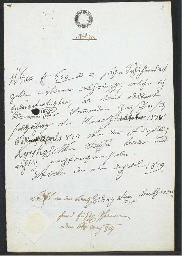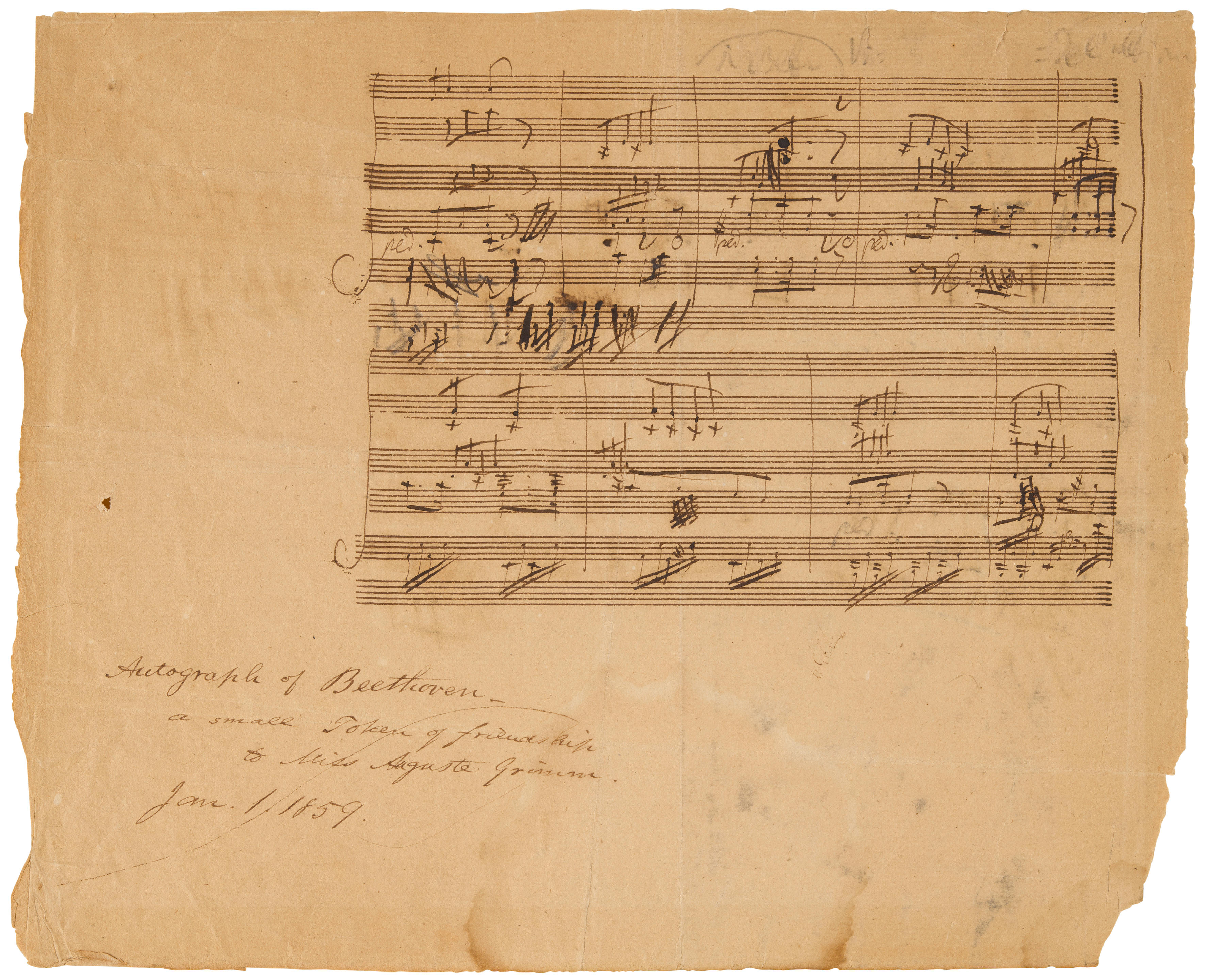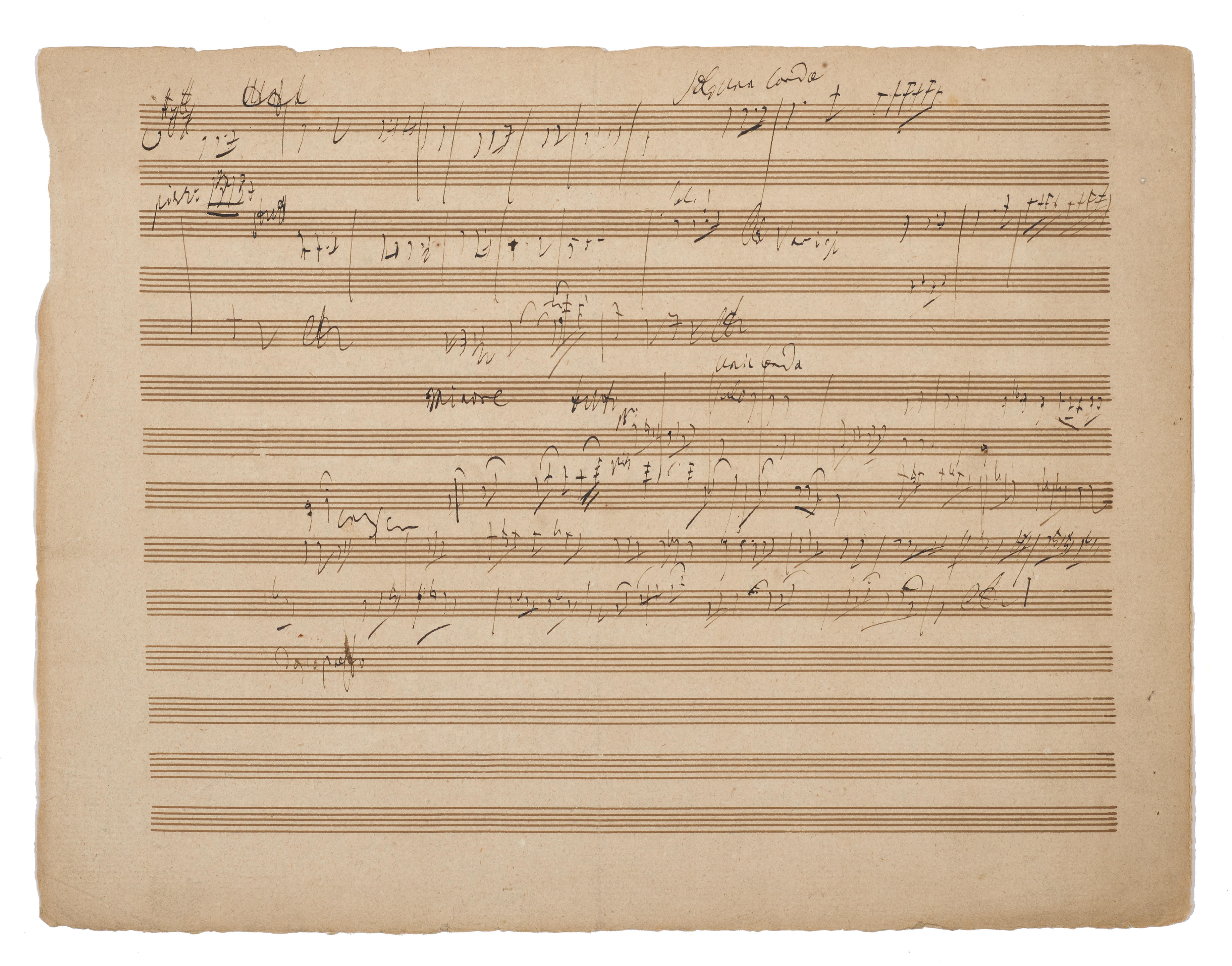Ludwig van Beethoven
Autograph manuscript of the Canon in C for three voices Ewig dein, WoO 161, SIGNED AT THE END ("...Freund Ludwig van Beethowen")
a fair copy by the composer, notated as a single vocal line on six staves, with cues marking the entries of the second and third voices, a few smudges, thirty-three bars in all
1 page, 18.2 x 19.1cm, cut from a larger leaf, correspondence stationery (watermark of a shield lettered "V P &..."), hand-ruled in pencil, formerly tipped on to card on the left-hand margin, now loose, modern silk portfolio in a red-gilt morocco slip-case, no place or date, [possibly c.1810-1812], remains of mount to verso
A BEETHOVEN DISCOVERY.
This long-lost manuscript of Beethoven's canon Ewig dein was first described in a letter of 1847 by C.F. Goffrié, now in the British Library, and then recorded in an English collection by C.F. Pohl in 1863 and by A.W. Thayer in 1865. It was recorded thus by Kinsky & Halm (Thematisch-bibliographisches Werkverzeichnis) in 1955, but the current editors (2014) take the view that it probably never existed at all, partly because all trace of it was apparently lost to Beethoven scholars after the original descriptions by Pohl and Thayer in 1863-1865.
In publishing the first edition in the Allgemeine musikalische Zeitung in 1863, Pohl explained: "Jos. Street Esqre in London is the owner of a three-voice Canon by Beethoven in his own handwriting. He was kind enough to furnish me with a copy of the same, so as to enable me to communicate it here [translation]". Pohl's edition shows the work as a single vocal line, as in the present manuscript, giving similar cues for the entry of the second and third voices (i.e., "verschlossene" or "closed", rather than written-out or realized in contrapuntal form). He provides no date, since there is none on this manuscript, and indeed it is not known precisely when Beethoven composed the work. A date of between 1810 and 1812 has been suggested; certainly the handwriting and the signature indicate it is earlier than c.1818-1819, when Beethoven ceased to sign in gothic script.
There is an undated eleven-bar draft in the Beethoven-Haus, Bonn, a "combination sketch" containing Beethoven's working-out of the last part where the three voices sing together. However, Pohl's source was the present manuscript of the canon in its "closed" form, via the transcript that Street gave him in 1863, and not the contrapuntal draft in Bonn. This manuscript also served as the model for a mid-nineteenth-century manuscript realization with English words in British Library Add MS 48590 G, which includes a transcription of Beethoven's signature at the end. Goffrié's 1847 letter is bound with that manuscript, where he offers to acquire the original autograph for Street, describing it as "a beautiful specimen...in the hands of a very old Gentleman who was a friend of Beethovens...It is a single leave [sic], six and a half inches square with six lines of music besides the text and his name at the end of it, it is also unpublished"): this must refer to the present manuscript, and not the contrapuntal draft in Bonn, which is only three lines and unsigned. However, the fact that the draft in Bonn was also once owned by Joseph Street doubtless contributed to the erroneous conclusion that only one of the two manuscripts ever existed (see the BL catalogue notes for Add MS 48590 G, and in the 2014 Werkverzeichnis).
According to Gustav Nottebohm, the canon, which could be described as a sign-off joke (its only words, 'ever your' ('Ewig dein'), preface as it were the word 'friend' ('Freund') before the signature), was supposedly composed for Baron Pasqualati (1777-1830), in whose house in Vienna the composer rented an apartment between 1804 and 1815. A different tradition, however, posits the former owner of the Beethoven-Haus draft, the actress Antonie Adamberger (1790-1867), as the inspiration for this playful jeu d'esprit.
This manuscript was part of the Arthur F. Hill collection, sold in these rooms in 1947 (apparently unnoticed by the 1955 and 2014 editors of the Werkverzeichnis), when it entered the present collection. It has effectively been lost to Beethoven scholarship since the 1860s.
LITERATURE:C.F. Goffrié, autograph letter to Joseph Street, London, 12 May 1847 (British Library Add. MS 48590G).C.F. Pohl, in the Allgemeine musikalische Zeitung, Neue Folge I (1863), no.51 (16 December) col. no.856 ("3 stimmiger Canon von Lud. v. Beethoven"). A.W. Thayer, Chronologisches Verzeichniss (1865), no.278 ("Ms. im Besitz des Herrn Joseph Street in London"). G. Kinsky & A. Halm, Das Werke Beethovens. Thematisch-bibliographisches Werkverzeichnis (1955), p.670 ("Autographen: 1) In einstimmig gesetzter Fassung: um 1865 bei Joseph Street in London...späterer Verbleib nicht bekannt").K. Dorfmüller, N. Gertsch & J. Ronge, Ludwig van Beethoven. Thematisch-bibliographisches Werkverzeichnis, Band 2 (2014), p.474 ("Entgegen KH (S.670) existierte vermutlich nie eine verschlossene Niederschrift").
PROVENANCE:"A very old Gentleman who was a friend of Beethoven" [possibly Mannheim], 1847; Joseph Street, London (1847-1860s); Arthur F. Hill F.S.A.; his sale at Sotheby's, 16 June 1947 (lot 255); Sotheby's, 26 October 2017 (lot 1)
Ludwig van Beethoven
Autograph manuscript of the Canon in C for three voices Ewig dein, WoO 161, SIGNED AT THE END ("...Freund Ludwig van Beethowen")
a fair copy by the composer, notated as a single vocal line on six staves, with cues marking the entries of the second and third voices, a few smudges, thirty-three bars in all
1 page, 18.2 x 19.1cm, cut from a larger leaf, correspondence stationery (watermark of a shield lettered "V P &..."), hand-ruled in pencil, formerly tipped on to card on the left-hand margin, now loose, modern silk portfolio in a red-gilt morocco slip-case, no place or date, [possibly c.1810-1812], remains of mount to verso
A BEETHOVEN DISCOVERY.
This long-lost manuscript of Beethoven's canon Ewig dein was first described in a letter of 1847 by C.F. Goffrié, now in the British Library, and then recorded in an English collection by C.F. Pohl in 1863 and by A.W. Thayer in 1865. It was recorded thus by Kinsky & Halm (Thematisch-bibliographisches Werkverzeichnis) in 1955, but the current editors (2014) take the view that it probably never existed at all, partly because all trace of it was apparently lost to Beethoven scholars after the original descriptions by Pohl and Thayer in 1863-1865.
In publishing the first edition in the Allgemeine musikalische Zeitung in 1863, Pohl explained: "Jos. Street Esqre in London is the owner of a three-voice Canon by Beethoven in his own handwriting. He was kind enough to furnish me with a copy of the same, so as to enable me to communicate it here [translation]". Pohl's edition shows the work as a single vocal line, as in the present manuscript, giving similar cues for the entry of the second and third voices (i.e., "verschlossene" or "closed", rather than written-out or realized in contrapuntal form). He provides no date, since there is none on this manuscript, and indeed it is not known precisely when Beethoven composed the work. A date of between 1810 and 1812 has been suggested; certainly the handwriting and the signature indicate it is earlier than c.1818-1819, when Beethoven ceased to sign in gothic script.
There is an undated eleven-bar draft in the Beethoven-Haus, Bonn, a "combination sketch" containing Beethoven's working-out of the last part where the three voices sing together. However, Pohl's source was the present manuscript of the canon in its "closed" form, via the transcript that Street gave him in 1863, and not the contrapuntal draft in Bonn. This manuscript also served as the model for a mid-nineteenth-century manuscript realization with English words in British Library Add MS 48590 G, which includes a transcription of Beethoven's signature at the end. Goffrié's 1847 letter is bound with that manuscript, where he offers to acquire the original autograph for Street, describing it as "a beautiful specimen...in the hands of a very old Gentleman who was a friend of Beethovens...It is a single leave [sic], six and a half inches square with six lines of music besides the text and his name at the end of it, it is also unpublished"): this must refer to the present manuscript, and not the contrapuntal draft in Bonn, which is only three lines and unsigned. However, the fact that the draft in Bonn was also once owned by Joseph Street doubtless contributed to the erroneous conclusion that only one of the two manuscripts ever existed (see the BL catalogue notes for Add MS 48590 G, and in the 2014 Werkverzeichnis).
According to Gustav Nottebohm, the canon, which could be described as a sign-off joke (its only words, 'ever your' ('Ewig dein'), preface as it were the word 'friend' ('Freund') before the signature), was supposedly composed for Baron Pasqualati (1777-1830), in whose house in Vienna the composer rented an apartment between 1804 and 1815. A different tradition, however, posits the former owner of the Beethoven-Haus draft, the actress Antonie Adamberger (1790-1867), as the inspiration for this playful jeu d'esprit.
This manuscript was part of the Arthur F. Hill collection, sold in these rooms in 1947 (apparently unnoticed by the 1955 and 2014 editors of the Werkverzeichnis), when it entered the present collection. It has effectively been lost to Beethoven scholarship since the 1860s.
LITERATURE:C.F. Goffrié, autograph letter to Joseph Street, London, 12 May 1847 (British Library Add. MS 48590G).C.F. Pohl, in the Allgemeine musikalische Zeitung, Neue Folge I (1863), no.51 (16 December) col. no.856 ("3 stimmiger Canon von Lud. v. Beethoven"). A.W. Thayer, Chronologisches Verzeichniss (1865), no.278 ("Ms. im Besitz des Herrn Joseph Street in London"). G. Kinsky & A. Halm, Das Werke Beethovens. Thematisch-bibliographisches Werkverzeichnis (1955), p.670 ("Autographen: 1) In einstimmig gesetzter Fassung: um 1865 bei Joseph Street in London...späterer Verbleib nicht bekannt").K. Dorfmüller, N. Gertsch & J. Ronge, Ludwig van Beethoven. Thematisch-bibliographisches Werkverzeichnis, Band 2 (2014), p.474 ("Entgegen KH (S.670) existierte vermutlich nie eine verschlossene Niederschrift").
PROVENANCE:"A very old Gentleman who was a friend of Beethoven" [possibly Mannheim], 1847; Joseph Street, London (1847-1860s); Arthur F. Hill F.S.A.; his sale at Sotheby's, 16 June 1947 (lot 255); Sotheby's, 26 October 2017 (lot 1)




.jpg)
.jpg)
.jpg)






Testen Sie LotSearch und seine Premium-Features 7 Tage - ohne Kosten!
Lassen Sie sich automatisch über neue Objekte in kommenden Auktionen benachrichtigen.
Suchauftrag anlegen